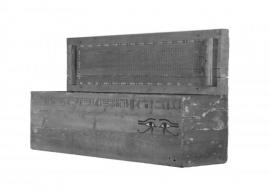The Oriental Institute recently received a grant from the Antiquities Endowment Fund of the American Research Center in Egypt (ARCE) to conserve an important ancient Egyptian coffin in our collection (OIM E12072). The First Intermediate Period (ca. 2064 BC) coffin of the commander and scribe of the army troops Ipi-ha-Ishutef was purchased by James Henry Breasted in Cairo in 1923. It is an excellent example of the coffin maker’s art, being constructed of large planks of what was assumed to be cedar from Lebanon. The outside is inscribed with funerary texts invoking offerings for the soul of Ipi-ha-Ishutef. A pair of wedjat eyes allowed the soul of the deceased to see the rising sun, a symbol of eternal rebirth. The interior is painted with a colorful scene of weapons, jewelry, food, and supplies for the soul of the deceased in the afterlife. The decoration also includes the representation of a door that allowed his spirit to leave the dark realm of the coffin to enjoy offerings left in the tomb. Unlike contemporary coffins inscribed with what are known as the Coffin Texts, the lid of this example bears an earlier composition known as the Pyramid Texts.


